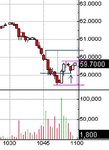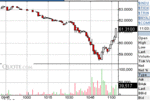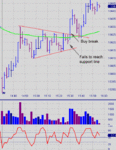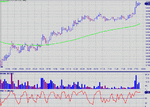charliechan
Experienced member
- Messages
- 1,008
- Likes
- 119
personally, i wouldnt take the trade based on the information given. i would want to see the activity on previous days before making a directional call. without this information, it becomes more of a gamble than a trade as the underlying strategy of those in the know remains unknown. was that decline a new multi day low? or was it simply a correction from a very strong close last night? in this sense, it is a trick question and really shouldnt be asked to newbie traders as it will only encourage wrong assumptions to be made with too little information.
so, without this information, i would be as objective as possible as it could go either way. based upon the cluster of price bars afetr the short rally, i would buy on an upside break, and sell on a down side break. as soon as one side was filled, i would place a stop on the other side for three times the size in case the first move was a fake. the 2nd move (if the first was a fake) is far more likely to be real. one size to cover the losing position, 2 size to make back my loss, 3 size to come out with a profit.
of course, there could be 2 fakes, in which case im well and truly in the hole. never mind, there is always tomorrow. if one was uneasy with such a strategy, then the sensible strategy would be to exercise some self discipline and wait for the market to show its hand and perhaps get in on a correction. no one is putting a gun to your head and saying you must trade here. it is better to wait for sure trades than gamble in uncertain conditions.
of course, playing guess the direction is the work of an analyst, and i have no intention of everbecoming some paper pushing analyst. as a trader, i know the secret to profit is the correct management of a trade, and myself - not guessing which direction it could go.
happy days
🙂
so, without this information, i would be as objective as possible as it could go either way. based upon the cluster of price bars afetr the short rally, i would buy on an upside break, and sell on a down side break. as soon as one side was filled, i would place a stop on the other side for three times the size in case the first move was a fake. the 2nd move (if the first was a fake) is far more likely to be real. one size to cover the losing position, 2 size to make back my loss, 3 size to come out with a profit.
of course, there could be 2 fakes, in which case im well and truly in the hole. never mind, there is always tomorrow. if one was uneasy with such a strategy, then the sensible strategy would be to exercise some self discipline and wait for the market to show its hand and perhaps get in on a correction. no one is putting a gun to your head and saying you must trade here. it is better to wait for sure trades than gamble in uncertain conditions.
of course, playing guess the direction is the work of an analyst, and i have no intention of everbecoming some paper pushing analyst. as a trader, i know the secret to profit is the correct management of a trade, and myself - not guessing which direction it could go.
happy days
🙂
Last edited:




